- Joined
- Feb 9, 2014
- Messages
- 20,922
- Name
- Peter
http://bleacherreport.com/articles/2477015-nfl-players-about-to-lose-their-jobs-to-rookies
NFL Players About to Lose Their Jobs to Rookies
By Justis Mosqueda, Featured Columnist May 27, 2015
The NFL may be exciting for fans, but it must be tough for veterans in the league. With more than 250 selections coming into the NFL, and even more undrafted rookies joining camp rosters, the competition becomes more vicious every year. Taking into account the larger veteran contracts juxtaposed to their rookie counterparts, the older members of the NFL need to be levels more talented than the developmental players who are long-term options.
Nevertheless, some rookies will contribute early on. While most people hold rookies to too high of a standard, assuming that three or four of them will become impact players on every squad, several prospects make the NFL transition quickly due to their elite athleticism.
Everyone assumes that the top two quarterbacks from the last class, Jameis Winston and Marcus Mariota, will start for their respective teams early on. Throwing them out, we'll take a look at who in the league looks to replace established options and make a significant splash during their rookie seasons.
Some of these soon-to-be-ousted players are former first-round picks. Some are second-year players who might have already passed up their one shot to prove they can be a 16-game starter. Others are just established veterans who are past their prime.
The NFL has no bias: If you're the best player, you'll see the field. As they say, the eye in the sky doesn't lie.
Tre Mason, RB, St. Louis Rams
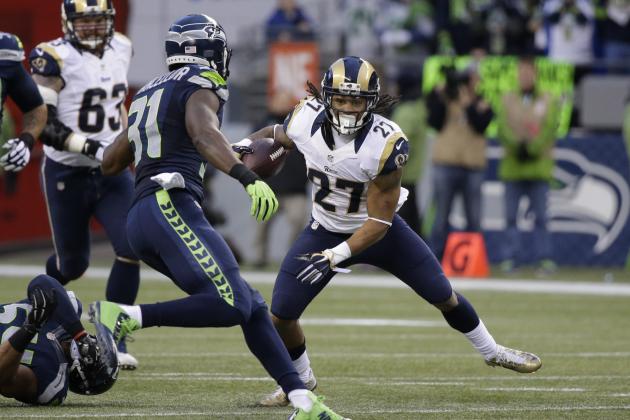
Elaine Thompson/Associated Press
With the second overall pick of the 2014 NFL draft, the St. Louis Rams took Greg Robinson out of Auburn as their left tackle of the future. Two rounds later, they picked up another former Tiger, Tre Mason. He scored 23 rushing touchdowns in his junior season, when the squad went to the national championship, and immediately declared as a professional.
Mason only saw the field for 12 of the Rams' 16 games during his rookie year, but he still managed to start in nine of them. Heading into the offseason, he was projected to be the starter, but a shocking pick led to him dropping down a peg.
With the 10th pick in 2015, St. Louis selected Todd Gurley of Georgia. Some considered him to be the best talent in college football last season, but after a suspension and ACL tear ruined his final year, he turned professional. He will miss time early on in the season with his knee recovery, but when he's healthy, the job is his.
The fact that the team took Gurley in the top 10, despite his inability to contribute early on in his rookie year, says big things about what the staff thinks of him. Jeff Fisher, the Rams' head coach, once went to a Super Bowl with Eddie George, whom Gurley compares to favorably.
Cullen Jenkins, DL, New York Giants
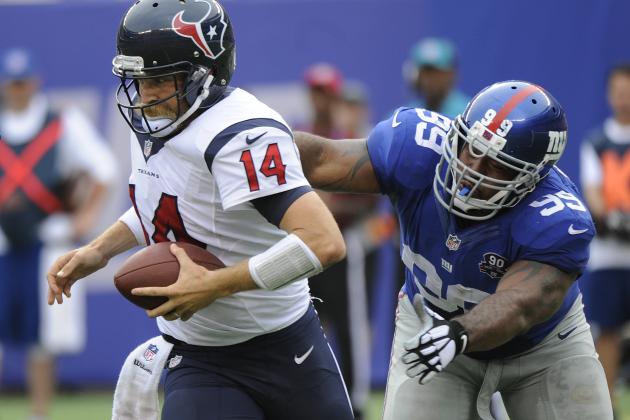
Bill Kostroun/Associated Press
In 11 starts last season, Cullen Jenkins only managed to bring in one sack for the New York Giants. In the recent past, Big Blue built two Super Bowl-winning rosters around the ability to get after the quarterback, putting three or four quality rushers on the field. Outside of Jason Pierre-Paul, there really wasn't even a second on the squad heading into the draft weekend.
Long gone are the days when Jenkins was helping the Green Bay Packers down their Super Bowl stretch. In the third round, the Giants acknowledged that flaw on their roster by taking Owamagbe Odighizuwa out of UCLA. He's a pass-rushing defensive end with issues surrounding the health of his hips, but New York has had success in a similar fashion before.
Justin Tuck, who won two rings and made two Pro Bowls during his time with the Giants, was a third-round pick out of Notre Dame who slipped due a knee issue. In many ways, Odighizuwa is a similar player to Tuck, who bumped into a pressure defensive tackle role in nickel and dime situations. With Pierre-Paul and Odighizuwa, the team may once again have a formative pass rush on its hands.
Devonta Freeman, RB, Atlanta
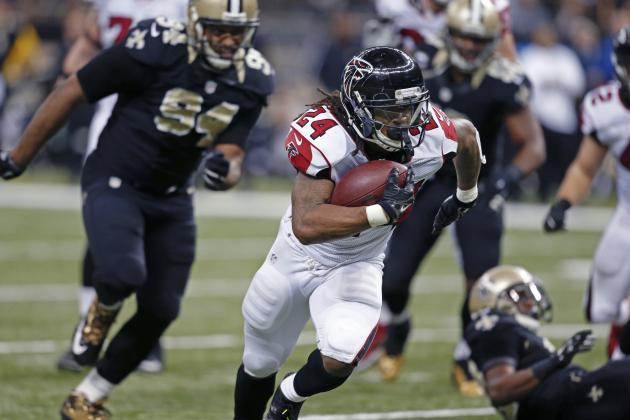
Rogelio Solis/Associated Press
When the Atlanta Falcons signed Steven Jackson in 2013, he immediately became the short-term starter for the franchise. After a long career with the St. Louis Rams, he started all of the 27 games he participated in with the Falcons over the course of the 2013 and 2014 seasons. At the age of 31, with 11 seasons under his belt, he was cut by Atlanta and is still a free agent.
Many assumed that Devonta Freeman, the team's second running back on the roster last season, would get the starting nod heading into the offseason. A fourth-round pick in 2014 out of Florida State, he had the makings of a potential every-down back, but with only 65 carries totaling for 248 yards and one score, he was no sure thing.
The Falcons took initiative to address the position in the draft, even though Freeman was already in the wings. Early in the third round, the squad selected Tevin Coleman out of the University of Indiana. He has one strong positive: He has the speed and stride to hit the home run ball.
Under a new coaching staff, Atlanta is trying to be a more zone blocking-based squad. Coleman has the makings of a Ryan Grant clone, who was able to post 1,000-yard seasons in Green Bay in a zone scheme. There's competition in the backfield, but expect Coleman to see time sooner than later, at the cost of Freeman.
Jarvis Jones, OLB, Pittsburgh Steelers
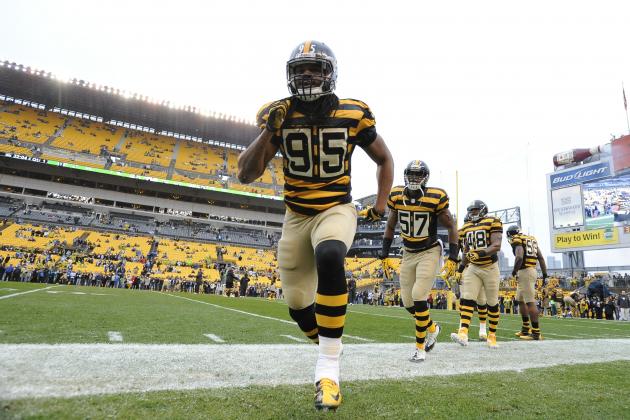
Don Wright/Associated Press
In 2013, Jarvis Jones was a first-round pick out of the University of Georgia. With production coming out of the Southeastern Conference (the top NFL talent-producing conference in college football), Jones was assumed to be a superstar. A lot of pass-rushing positions in the NFL are based off pure athleticism, though, and Jones ranked poor onMock Draftable's spider chart of combine testing.
He has been hindered by physical limitations during his career, only notching three sacks in his two years in the pros. The team even brought back James Harrison, who is closer to being a 40-year-old than a 30-year-old, and was forced to transition tag Jason Worilds, who is now retired.
The team had two options this offseason: (1) admit its mistake and draft a pass-rusher high in the draft or (2) live in a world where it once more attempted to throw Jones in as a premier edge player in the defense. One of the players who "fell" the most on media boards during Day 1 of the draft was Alvin "Bud" Dupree, a pass-rusher from the University of Kentucky.
Dupree was overlooked by the New York Jets, who took a slipping Leonard Williams, and by the Atlanta Falcons, who selected Vic Beasley, another pass-rusher. The tumble for Dupree didn't stop in the top 10, as it did for Williams, but at the 22nd pick, a perfect situation for the Steelers. He may develop into a Cameron Wake type of player, and he should have Jones coming off the bench from Week 1 on.
Jeremy Mincey, DE, Dallas Cowboys
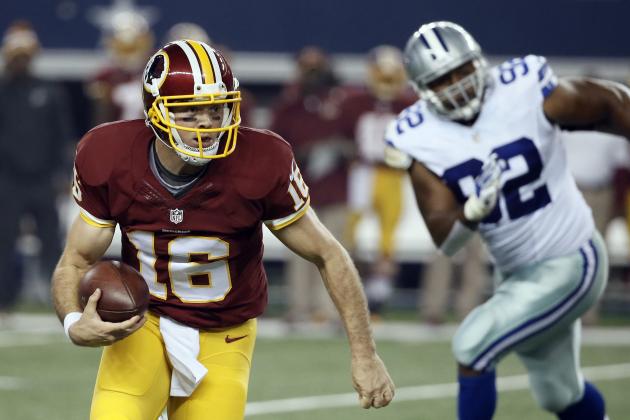
Brandon Wade/Associated Press
At 31 years old, Jeremy Mincey is no spring chicken. Before signing with the Dallas Cowboys last season, he hadn't been a starter since 2012, two teams removed from his Cowboys move. In his nine-year career, he's also only cracked five sacks in a season twice.
What Dallas badly needs is a threat to pressure passers. Defense is more about the sum of the parts than individuals, but one can make the case that a good pass-rusher is the second-most impactful player in the NFL, only behind franchise quarterbacks. Luckily for the Cowboys, they had Rod Marinelli as a coach on the defensive side, and he was able to mask a lot of their flaws, but they still didn't do enough to get into the NFC Championship Game, despite their amazing offense.
In the late second round, the team selected Randy Gregory out of Nebraska. Before he failed the combine's drug test, he was considered to be a top-five lock as the best pure pass-rusher in class. The Cowboys have built a culture around their team to help players who need it, such as star receiver Dez Bryant. Under Marinelli's coaching, Gregory could develop into a Pro Bowler within a few years, and it will be hard to keep him on the bench for long.
Muhammad Wilkerson, DL, New York Jets
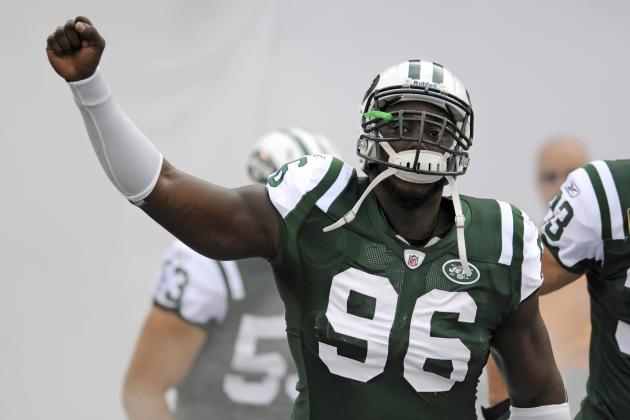
Bill Kostroun/Associated Press
Muhammad Wilkerson is one of the more interesting current storylines in the NFL. He is on the last year of his contract, and as a successful former first-round pick, one would bet he's ready to cash in. The New York Jets also have Sheldon Richardson next to him as a 3-4 starting defensive end and just drafted Leonard Williams out of USC as the sixth overall pick.
Jason Cole of Bleacher Report reported that Wilkerson is expected to be on the trading block. This weekend, Jason La Canfora of CBS Sportsalso said the Lions "could address" defensive tackle via a trade. Wilkerson seems like the top option for Detroit.
There are three valuable mouths to feed in New York but only two seats at the table. The Jets have to make a move fairly soon, but getting Williams more reps than Wilkerson will help them for the future, which is what they should be planning for, as their offense isn't at the level to where they can compete for a championship just yet.
By way of trade or benching, Williams will soon have Wilkerson's starting role across from Richardson. The player who was labeled as the top defensive athlete in the draft class shouldn't be coming off the bench for long.
Andre Ellington, RB, Arizona Cardinals
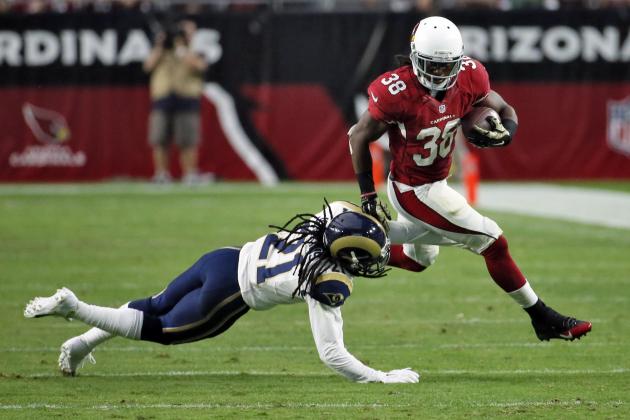
Matt York/Associated Press
Last season, there were hopes coming into the year that Andre Ellington would develop into one of the NFL's top backs. Looking back, it feels like a much longer time removed from that period. He came into the league as an undersized (5'9", 199 lbs) sixth-round pick.
He's both a pass-catcher and runner who ran a poor 40-yard dash time (4.61), which was often repeated during his time as a prospect. In his first year, though, he silenced doubters. Despite only starting one game, he averaged 5.5 yards per carry.
With the full-time gig in his hands as a sophomore in 2014, many across the media believed he was going to run away with the opportunity, and he had a big buzz in the fantasy football community.
Unfortunately, when he was fed his healthy helping of touches, he crashed back down to earth. He dropped his average down to 3.3 yards per carry, two full yards below his previous clip. In 12 starts, he was able to only put up eight more yards on the ground than in his rookie year, where he was basically a bench player.
In the third round of the draft, the Cardinals took David Johnson out of Northern Iowa. He was one of the best small-school prospects in the class, and he's comparable to Matt Forte. If Johnson can develop as quickly as Forte did, he should be a Pro Bowl player during his career. He can run or catch out of the backfield like Ellington but has a higher upside, which should vault the rookie into the starting lineup and the incumbent to the pine.
NFL Players About to Lose Their Jobs to Rookies
By Justis Mosqueda, Featured Columnist May 27, 2015
The NFL may be exciting for fans, but it must be tough for veterans in the league. With more than 250 selections coming into the NFL, and even more undrafted rookies joining camp rosters, the competition becomes more vicious every year. Taking into account the larger veteran contracts juxtaposed to their rookie counterparts, the older members of the NFL need to be levels more talented than the developmental players who are long-term options.
Nevertheless, some rookies will contribute early on. While most people hold rookies to too high of a standard, assuming that three or four of them will become impact players on every squad, several prospects make the NFL transition quickly due to their elite athleticism.
Everyone assumes that the top two quarterbacks from the last class, Jameis Winston and Marcus Mariota, will start for their respective teams early on. Throwing them out, we'll take a look at who in the league looks to replace established options and make a significant splash during their rookie seasons.
Some of these soon-to-be-ousted players are former first-round picks. Some are second-year players who might have already passed up their one shot to prove they can be a 16-game starter. Others are just established veterans who are past their prime.
The NFL has no bias: If you're the best player, you'll see the field. As they say, the eye in the sky doesn't lie.
Tre Mason, RB, St. Louis Rams

Elaine Thompson/Associated Press
With the second overall pick of the 2014 NFL draft, the St. Louis Rams took Greg Robinson out of Auburn as their left tackle of the future. Two rounds later, they picked up another former Tiger, Tre Mason. He scored 23 rushing touchdowns in his junior season, when the squad went to the national championship, and immediately declared as a professional.
Mason only saw the field for 12 of the Rams' 16 games during his rookie year, but he still managed to start in nine of them. Heading into the offseason, he was projected to be the starter, but a shocking pick led to him dropping down a peg.
With the 10th pick in 2015, St. Louis selected Todd Gurley of Georgia. Some considered him to be the best talent in college football last season, but after a suspension and ACL tear ruined his final year, he turned professional. He will miss time early on in the season with his knee recovery, but when he's healthy, the job is his.
The fact that the team took Gurley in the top 10, despite his inability to contribute early on in his rookie year, says big things about what the staff thinks of him. Jeff Fisher, the Rams' head coach, once went to a Super Bowl with Eddie George, whom Gurley compares to favorably.
Cullen Jenkins, DL, New York Giants

Bill Kostroun/Associated Press
In 11 starts last season, Cullen Jenkins only managed to bring in one sack for the New York Giants. In the recent past, Big Blue built two Super Bowl-winning rosters around the ability to get after the quarterback, putting three or four quality rushers on the field. Outside of Jason Pierre-Paul, there really wasn't even a second on the squad heading into the draft weekend.
Long gone are the days when Jenkins was helping the Green Bay Packers down their Super Bowl stretch. In the third round, the Giants acknowledged that flaw on their roster by taking Owamagbe Odighizuwa out of UCLA. He's a pass-rushing defensive end with issues surrounding the health of his hips, but New York has had success in a similar fashion before.
Justin Tuck, who won two rings and made two Pro Bowls during his time with the Giants, was a third-round pick out of Notre Dame who slipped due a knee issue. In many ways, Odighizuwa is a similar player to Tuck, who bumped into a pressure defensive tackle role in nickel and dime situations. With Pierre-Paul and Odighizuwa, the team may once again have a formative pass rush on its hands.
Devonta Freeman, RB, Atlanta

Rogelio Solis/Associated Press
When the Atlanta Falcons signed Steven Jackson in 2013, he immediately became the short-term starter for the franchise. After a long career with the St. Louis Rams, he started all of the 27 games he participated in with the Falcons over the course of the 2013 and 2014 seasons. At the age of 31, with 11 seasons under his belt, he was cut by Atlanta and is still a free agent.
Many assumed that Devonta Freeman, the team's second running back on the roster last season, would get the starting nod heading into the offseason. A fourth-round pick in 2014 out of Florida State, he had the makings of a potential every-down back, but with only 65 carries totaling for 248 yards and one score, he was no sure thing.
The Falcons took initiative to address the position in the draft, even though Freeman was already in the wings. Early in the third round, the squad selected Tevin Coleman out of the University of Indiana. He has one strong positive: He has the speed and stride to hit the home run ball.
Under a new coaching staff, Atlanta is trying to be a more zone blocking-based squad. Coleman has the makings of a Ryan Grant clone, who was able to post 1,000-yard seasons in Green Bay in a zone scheme. There's competition in the backfield, but expect Coleman to see time sooner than later, at the cost of Freeman.
Jarvis Jones, OLB, Pittsburgh Steelers

Don Wright/Associated Press
In 2013, Jarvis Jones was a first-round pick out of the University of Georgia. With production coming out of the Southeastern Conference (the top NFL talent-producing conference in college football), Jones was assumed to be a superstar. A lot of pass-rushing positions in the NFL are based off pure athleticism, though, and Jones ranked poor onMock Draftable's spider chart of combine testing.
He has been hindered by physical limitations during his career, only notching three sacks in his two years in the pros. The team even brought back James Harrison, who is closer to being a 40-year-old than a 30-year-old, and was forced to transition tag Jason Worilds, who is now retired.
The team had two options this offseason: (1) admit its mistake and draft a pass-rusher high in the draft or (2) live in a world where it once more attempted to throw Jones in as a premier edge player in the defense. One of the players who "fell" the most on media boards during Day 1 of the draft was Alvin "Bud" Dupree, a pass-rusher from the University of Kentucky.
Dupree was overlooked by the New York Jets, who took a slipping Leonard Williams, and by the Atlanta Falcons, who selected Vic Beasley, another pass-rusher. The tumble for Dupree didn't stop in the top 10, as it did for Williams, but at the 22nd pick, a perfect situation for the Steelers. He may develop into a Cameron Wake type of player, and he should have Jones coming off the bench from Week 1 on.
Jeremy Mincey, DE, Dallas Cowboys

Brandon Wade/Associated Press
At 31 years old, Jeremy Mincey is no spring chicken. Before signing with the Dallas Cowboys last season, he hadn't been a starter since 2012, two teams removed from his Cowboys move. In his nine-year career, he's also only cracked five sacks in a season twice.
What Dallas badly needs is a threat to pressure passers. Defense is more about the sum of the parts than individuals, but one can make the case that a good pass-rusher is the second-most impactful player in the NFL, only behind franchise quarterbacks. Luckily for the Cowboys, they had Rod Marinelli as a coach on the defensive side, and he was able to mask a lot of their flaws, but they still didn't do enough to get into the NFC Championship Game, despite their amazing offense.
In the late second round, the team selected Randy Gregory out of Nebraska. Before he failed the combine's drug test, he was considered to be a top-five lock as the best pure pass-rusher in class. The Cowboys have built a culture around their team to help players who need it, such as star receiver Dez Bryant. Under Marinelli's coaching, Gregory could develop into a Pro Bowler within a few years, and it will be hard to keep him on the bench for long.
Muhammad Wilkerson, DL, New York Jets

Bill Kostroun/Associated Press
Muhammad Wilkerson is one of the more interesting current storylines in the NFL. He is on the last year of his contract, and as a successful former first-round pick, one would bet he's ready to cash in. The New York Jets also have Sheldon Richardson next to him as a 3-4 starting defensive end and just drafted Leonard Williams out of USC as the sixth overall pick.
Jason Cole of Bleacher Report reported that Wilkerson is expected to be on the trading block. This weekend, Jason La Canfora of CBS Sportsalso said the Lions "could address" defensive tackle via a trade. Wilkerson seems like the top option for Detroit.
There are three valuable mouths to feed in New York but only two seats at the table. The Jets have to make a move fairly soon, but getting Williams more reps than Wilkerson will help them for the future, which is what they should be planning for, as their offense isn't at the level to where they can compete for a championship just yet.
By way of trade or benching, Williams will soon have Wilkerson's starting role across from Richardson. The player who was labeled as the top defensive athlete in the draft class shouldn't be coming off the bench for long.
Andre Ellington, RB, Arizona Cardinals

Matt York/Associated Press
Last season, there were hopes coming into the year that Andre Ellington would develop into one of the NFL's top backs. Looking back, it feels like a much longer time removed from that period. He came into the league as an undersized (5'9", 199 lbs) sixth-round pick.
He's both a pass-catcher and runner who ran a poor 40-yard dash time (4.61), which was often repeated during his time as a prospect. In his first year, though, he silenced doubters. Despite only starting one game, he averaged 5.5 yards per carry.
With the full-time gig in his hands as a sophomore in 2014, many across the media believed he was going to run away with the opportunity, and he had a big buzz in the fantasy football community.
Unfortunately, when he was fed his healthy helping of touches, he crashed back down to earth. He dropped his average down to 3.3 yards per carry, two full yards below his previous clip. In 12 starts, he was able to only put up eight more yards on the ground than in his rookie year, where he was basically a bench player.
In the third round of the draft, the Cardinals took David Johnson out of Northern Iowa. He was one of the best small-school prospects in the class, and he's comparable to Matt Forte. If Johnson can develop as quickly as Forte did, he should be a Pro Bowl player during his career. He can run or catch out of the backfield like Ellington but has a higher upside, which should vault the rookie into the starting lineup and the incumbent to the pine.
